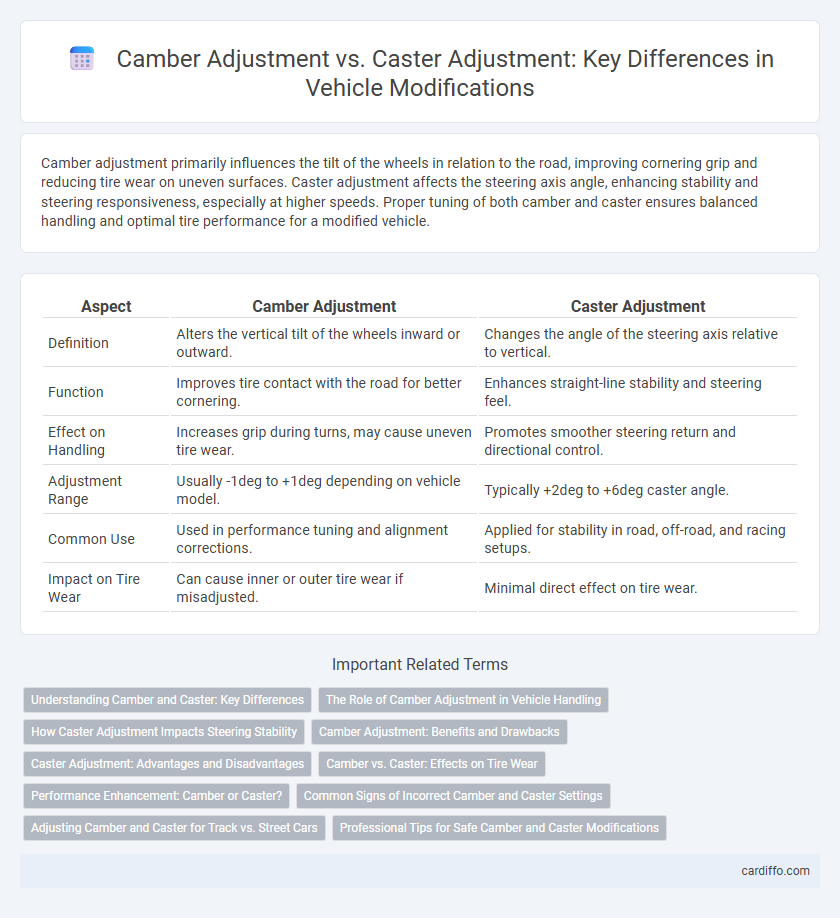Camber adjustment primarily influences the tilt of the wheels in relation to the road, improving cornering grip and reducing tire wear on uneven surfaces. Caster adjustment affects the steering axis angle, enhancing stability and steering responsiveness, especially at higher speeds. Proper tuning of both camber and caster ensures balanced handling and optimal tire performance for a modified vehicle.
Table of Comparison
| Aspect | Camber Adjustment | Caster Adjustment |
|---|---|---|
| Definition | Alters the vertical tilt of the wheels inward or outward. | Changes the angle of the steering axis relative to vertical. |
| Function | Improves tire contact with the road for better cornering. | Enhances straight-line stability and steering feel. |
| Effect on Handling | Increases grip during turns, may cause uneven tire wear. | Promotes smoother steering return and directional control. |
| Adjustment Range | Usually -1deg to +1deg depending on vehicle model. | Typically +2deg to +6deg caster angle. |
| Common Use | Used in performance tuning and alignment corrections. | Applied for stability in road, off-road, and racing setups. |
| Impact on Tire Wear | Can cause inner or outer tire wear if misadjusted. | Minimal direct effect on tire wear. |
Understanding Camber and Caster: Key Differences
Camber adjustment alters the tilt of the wheels inward or outward, directly impacting tire wear and cornering performance. Caster adjustment changes the angle of the steering pivot, influencing steering stability and self-centering behavior. Understanding these key differences helps optimize vehicle handling and alignment for improved safety and driving comfort.
The Role of Camber Adjustment in Vehicle Handling
Camber adjustment directly influences tire contact patch during cornering, enhancing grip and stability by optimizing the angle of the wheels relative to the road surface. Unlike caster adjustment, which primarily affects steering feel and straight-line stability, camber modification plays a critical role in minimizing tire wear and improving cornering performance. Proper camber settings contribute to balanced handling dynamics, ensuring improved traction and vehicle control in various driving conditions.
How Caster Adjustment Impacts Steering Stability
Caster adjustment directly influences steering stability by altering the angle of the steering axis, which affects the self-centering behavior of the wheels. Increasing positive caster enhances straight-line stability and improves cornering by providing better directional control. Proper caster settings reduce steering effort and minimize road feedback, resulting in a smoother and more controlled driving experience.
Camber Adjustment: Benefits and Drawbacks
Camber adjustment optimizes tire contact with the road, enhancing cornering grip and handling stability. Excessive negative camber can lead to uneven tire wear and reduced straight-line traction. Proper camber tuning balances performance gains against potential tire wear and vehicle alignment issues.
Caster Adjustment: Advantages and Disadvantages
Caster adjustment improves vehicle stability, steering feel, and cornering performance by altering the angle of the steering axis relative to vertical. Advantages include enhanced straight-line tracking, reduced steering effort, and improved self-centering of the steering wheel. Disadvantages involve potential increased tire wear if misaligned and the complexity of adjustments requiring precise alignment equipment.
Camber vs. Caster: Effects on Tire Wear
Camber adjustment alters the vertical tilt of the tires, significantly impacting tire wear by causing uneven wear on the inside or outside edges. Caster adjustment affects the steering axis angle for vehicle stability but has minimal direct influence on tire wear compared to camber. Proper camber settings optimize tire contact with the road surface, reducing premature wear and enhancing overall tire lifespan.
Performance Enhancement: Camber or Caster?
Camber adjustment directly impacts cornering grip by optimizing tire contact patches, enhancing lateral stability during high-speed turns for better performance. Caster adjustment primarily influences steering feel and straight-line stability, improving vehicle responsiveness and driver control under dynamic driving conditions. For performance enhancement, precise camber tuning is crucial on track-focused setups, while caster adjustments benefit overall handling balance and driver feedback.
Common Signs of Incorrect Camber and Caster Settings
Incorrect camber settings often cause uneven tire wear, especially excessive wear on the inner or outer edges, and can lead to poor handling and reduced steering response. Incorrect caster settings typically result in unstable steering, increased effort to maintain a straight line, and difficulty returning the steering wheel to center after turns. Both camber and caster misalignments contribute to compromised vehicle stability and increased tire wear, impacting overall driving safety and comfort.
Adjusting Camber and Caster for Track vs. Street Cars
Adjusting camber for track cars typically involves increasing negative camber to enhance cornering grip and tire contact during aggressive turns, while street cars benefit from a more neutral camber to ensure even tire wear and stable handling in everyday driving conditions. Caster adjustment on track vehicles often leans towards a higher positive angle to improve high-speed stability and steering feedback, whereas street cars maintain moderate positive caster to balance ease of steering with straight-line stability. Optimal camber and caster settings depend on vehicle use, tire type, and suspension design, making precise tuning essential for performance and safety on both track and street environments.
Professional Tips for Safe Camber and Caster Modifications
Professional tips for safe camber and caster modifications emphasize precise measurement using alignment machines to ensure accuracy. Always adjust one parameter at a time, starting with caster before camber, to maintain vehicle stability and handling performance. Using high-quality adjustable control arms and regularly inspecting suspension components reduces risk of uneven tire wear and alignment issues.
Camber Adjustment vs Caster Adjustment Infographic

 cardiffo.com
cardiffo.com